3D printing has garnered much attention in the past three decades with its wide range of applications. The ongoing development in this area needs more modern feedstock materials with enhanced properties and functionality. This article details the production of printable composite filaments and their characterization concerning morphology and thermal and mechanical properties, as outlined in a study in the journal Materials.
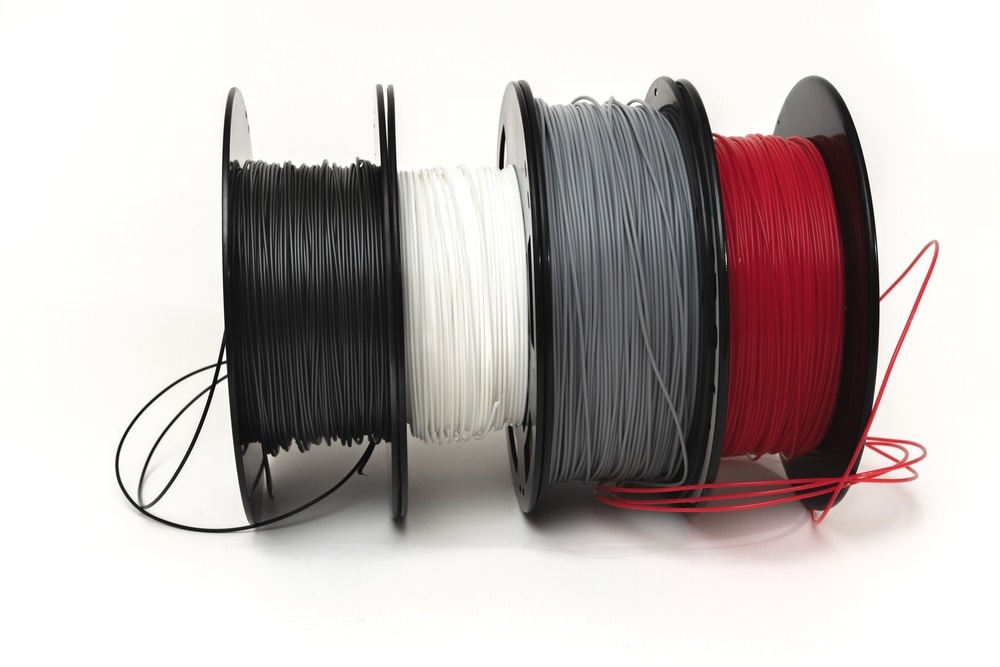
Study: High-Impact Polystyrene Reinforced with Reduced Graphene Oxide as a Filament for Fused Filament Fabrication 3D Printing. Image Credit: HannaTor/Shutterstock.com
Additive manufacturing (AM), also called 3D printing, has become increasingly popular in the last three decades. The AM process is divided into seven categories depending on the printing mechanism, with selective laser sintering (SLS) or melting (SLM), stereolithography (SLA), fused filament fabrication (FFF), and laminated object manufacturing (LOM) being used commonly. This is further explored in the journal Materials.
This technique has numerous advantages compared to traditional manufacturing techniques. 3D printing produces elements with complex geometry otherwise difficult to obtain with conventional methods, and the complex geometry does not affect the final cost.
Polymers are the most widely used materials in the 3D printing industry. 3D printing is found applied in numerous areas like biomedicine, electronics, aerospace and the automotive industry, sports, and buildings. Also, 3D printing has recently been used in producing personal protective equipment (PPE).
Among the various techniques, fused filament fabrication is widely used and rapidly developing. Polymers generally used to produce the filaments include acrylonitrile-styrene-acrylate (ASA), acrylonitrile-butadiene-styrene (ABS), polyamide (PA), poly(lactic acid) (PLA), polycarbonate (PC),and polycaprolactone (PCL), along with recycled polymers.
High-impact polystyrene (HIPS) has garnered attention and is used in prototyping. To create feedstock materials with enhanced properties, graphene can be introduced into the polymer matrix. This introduction improves the thermal, electrical, and mechanical properties of pure polymers.
This article is the first of its kind to investigate printable high-impact polystyrene/reduced graphene oxide composite filaments. The method employed was fused filament fabrication, and the produced filaments were characterized concerning morphology and thermal and mechanical properties. The article also provides the preliminary test results of the obtained printed parts.
Methodology
High-impact polystyrene (HIPS) and reagents like graphite powder, KMnO4, 30% H2O2, and 98% H2SO4 created graphene oxide, which was later purified. Reduced graphene oxide (rGO) was generated with thermal reduction.
HIPS/rGO filaments were produced using a two-stage process—the first step involvied the preparation of a masterbatch, and in the next step, the masterbatch was chopped into pellets and re-extruded to create a filament with a uniform diameter of 1.75 mm.
Figure 1 illustrates pictures of the HIPS materials at various production stages.
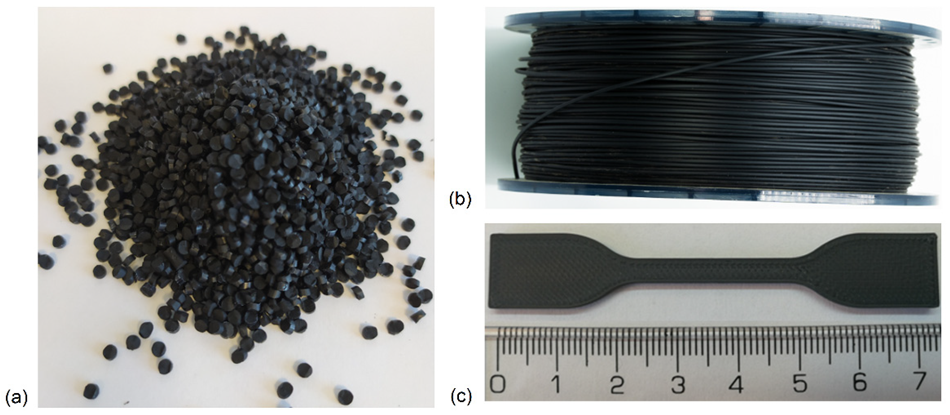
Pellets of a masterbatch containing 10 wt% rGO (a); HIPS filament with 0.5 wt% rGO content (b); tensile bar HIPS-0.5 (c). Image Credit: Sieradzka, et al., 2021
A Phenom ProX scanning electron microscope (SEM) was employed to analyze the morphology of the filaments, and the samples were coated with a ~10 nm layer of gold. The elemental composition of the reduced graphene oxide was analyzed using an energy-dispersive spectrometer (EDS).
Fourier Transform Infrared Spectroscopy (FTIR) analysis was carried out, and the OMNIC software was applied to gather data and post-processing. A differential scanning calorimetry (DSC) was performed, and the glass transition temperatures were evaluated depending on the curves.
Thermogravimetric Analyzer Q500 was used to analyze the thermal properties of the samples and the melt flow rate (MFR) measurements were carried out using a Modular Melt Flow. The researchers also tested the tensile properties of HIPS filaments.
Results
Figures 2 and 3 illustrate the cross-sectional SEM images of both the pure HIPS filament and the HIPS filament reinforced with reduced graphene oxide. The observations show that at a lower concentration of rGO, there are no issues with the miscibility of the polymer matrix and the additive. However, when the concentration is exceeded, agglomerates are formed.
Further research showed that aggregation of the additive impacts the properties of the obtained composites.
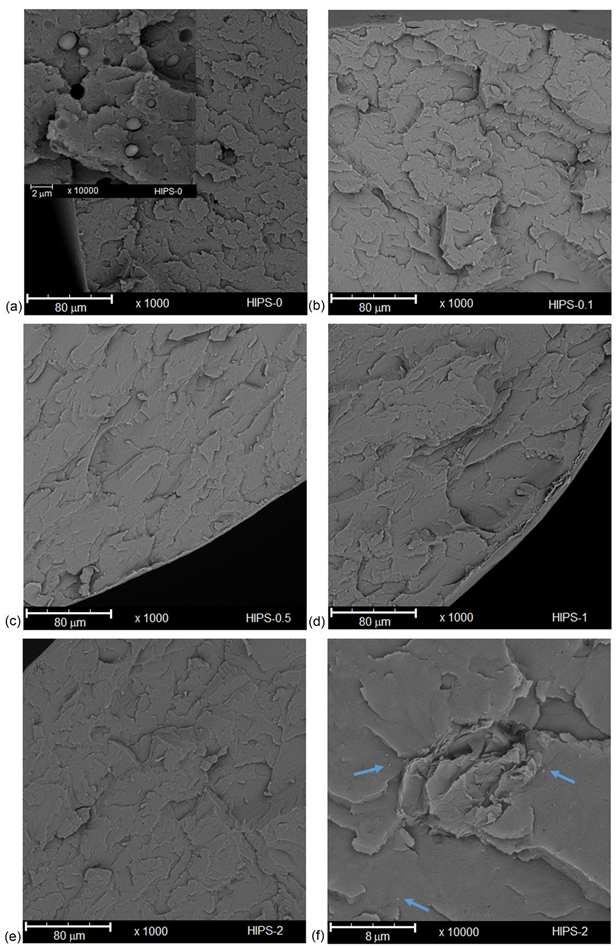
Cross-section of HIPS-0 and HIPS composites: HIPS-0 (a); HIPS-0.1 (b); HIPS-0.5 (c); HIPS-1 (d); HIPS-2 (e, f). Image Credit: Sieradzka, et al., 2021
Figure 3 depicts the cross-sectional SEM images of the masterbatch filament, and the observation shows numerous agglomerates of reduced graphene oxide that influence the mechanical properties of the sample.
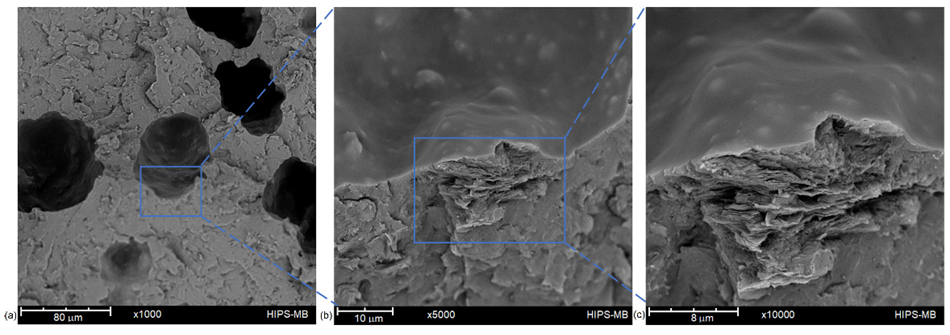
Cross-section of masterbatch filament at different magnifications: ×1000 magnification (a); ×5000 magnification (b); ×10,000 magnification (c). Image Credit: Sieradzka, et al., 2021
Figure 4 shows the FTIR test results for pure HIPS filament samples and samples of various rGO content in the range of 3150 cm−1–2780 cm−1.
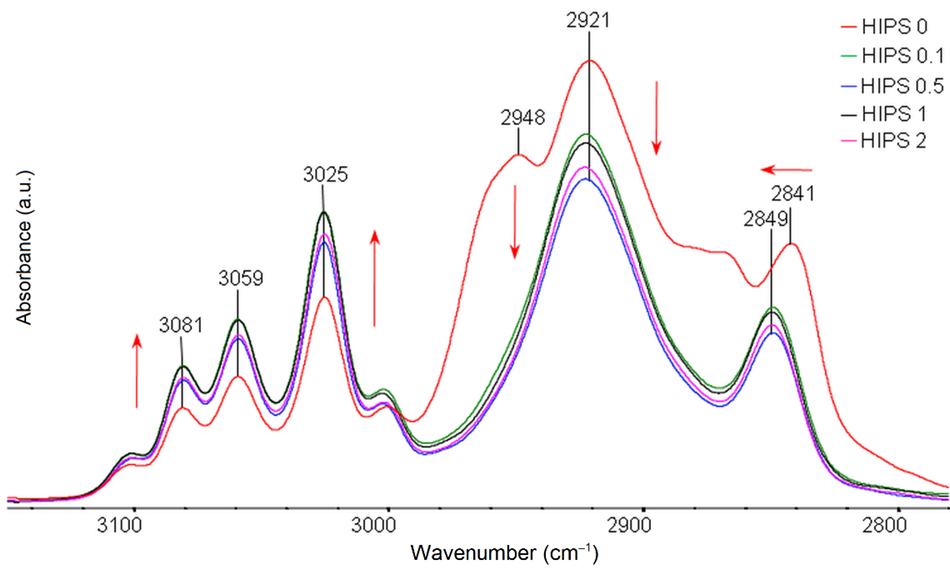
Summary of FTIR spectra for pure HIPS filaments and HIPS filaments with the addition of rGO in a range of 3150 cm−1–2780 cm−1. Image Credit: Sieradzka, et al., 2021
The FTIR spectra analysis for HIPS samples with various rGO content does not show the direct development of new absorption bands. Moreover, the FTIR spectra for the fingerprint region show a decrease in the intensity of radiation absorption.
The melt flow rate (MFR) measurements determining the flowability of the HIPS and HIPS/rGO filaments showed that the values of rGO-containing filaments were slightly lesser than those of pure HIPS.
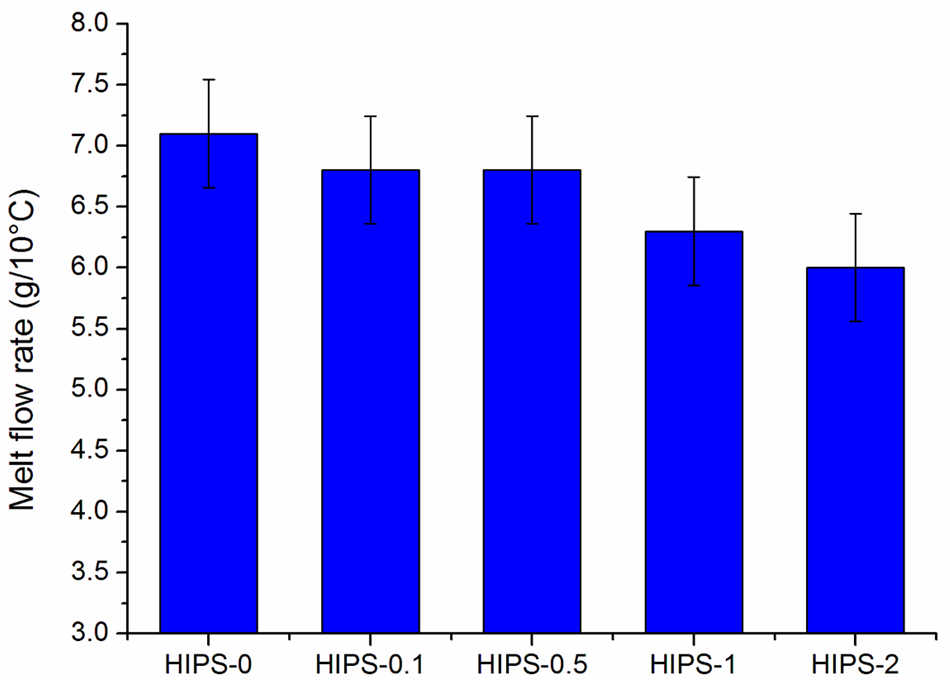
Melt flow rate (MFR) of the pure HIPS filament and the HIPS/rGO composite filaments. Image Credit: Sieradzka, et al., 2021
The filament without added rGO depicted the lowest Tg value. The Tg values were determined based on the DSC curves after melting the filaments.
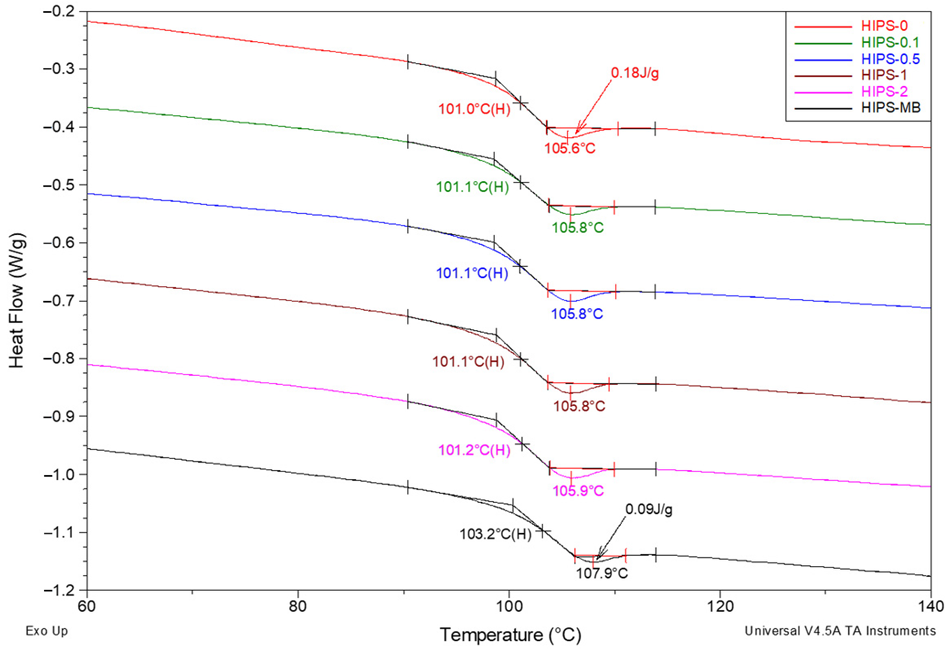
Summary of DSC curves for a series of HIPS samples, created after melting the filaments, registered during the second heating cycle in the range between 40 °C and 140 °C. Measurements were carried out under a nitrogen atmosphere, measurement conditions as above. Analysis of the thermal glass transition area. Image Credit: Sieradzka, et al., 2021
The effects of rGO on the thermal properties of HIPS samples were based on the results obtained from thermogravimetric studies. Figure 9 shows the two ways in which the thermal stability of the samples during heating under a nitrogen atmosphere was evaluated.
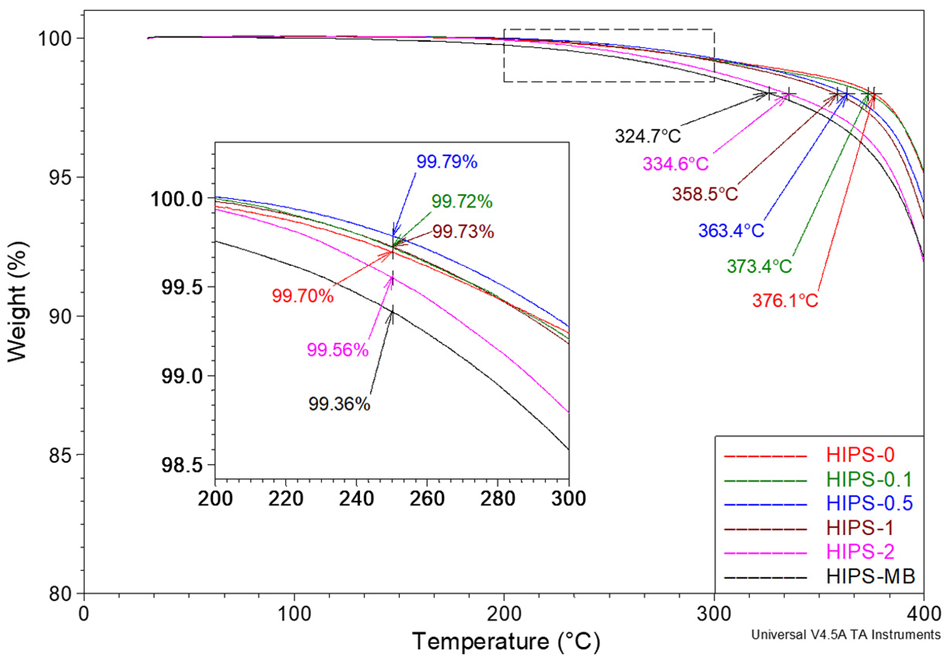
Summary of TG curves for a series of HIPS filaments registered at a heating rate of 20 °C/min. Measurements ranging from 30 to 400 °C under nitrogen atmosphere. Purge flow 60 mL/min. The figure shows the 2% mass loss temperature and the analysis of the thermal stability of the samples at 250 °C (insert view). Image Credit: Sieradzka, et al., 2021
Figure 10 shows the analysis of the DTG curves, which demonstrated that the temperature of the highest mass loss rate in this transition also reduced with the increase in rGO content.
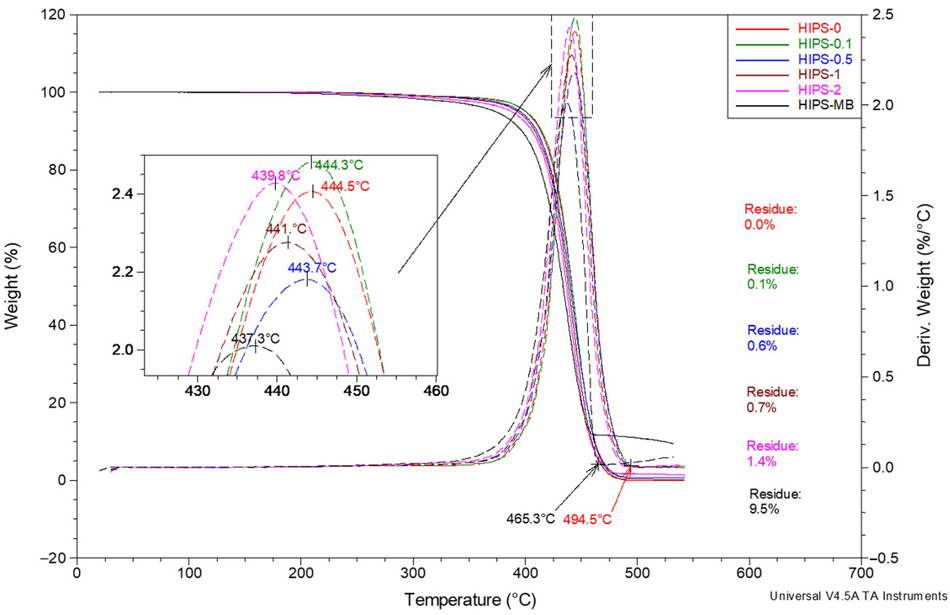
Summary of TG and DTG curves for a series of HIPS filaments registered at a heating rate of 20 °C/min. Measurements ranging from 30 °C to 540 °C under nitrogen atmosphere. Purge flow 60 mL/min. Analysis of the HIPS thermal dissociation area. Image Credit: Sieradzka, et al., 2021
Thermogravimetric studies revealed that the thermal stability of the composite samples was decreased at temperatures above 250 °C.
The HIPS filaments with reduced graphene oxide were analyzed for their suitability for 3D printing and found that the HIPS/rGO composite was effectively printed with similar conditions as pure HIPS. No difficulties were observed during printing; also, SEM studies did not show any visible agglomerates.
The Tg of pure HIPS and HIPS/rGO composites varied slightly, and there was no change in the glass transition temperature after remelting. When analyzed for mechanical properties, it was noted that the addition of reduced graphene oxide did not enhance the mechanical properties.
Conclusion
This article elaborates on a process of obtaining filaments from high-impact polystyrene by adding reduced graphene oxide for fused filament fabrication (FFF). The prepared HIPS/rGO composite filaments were characterized and analyzed. The various analytical methods used indicate that the production of a filament featuring reduced graphene oxide provides an opportunity for the use of this additive in additive manufacturing.
Journal Reference:
Sieradzka, M., Fabia, J., Biniaś, D., Graczyk, T., Fryczkowski, R. (2021) High-Impact Polystyrene Reinforced with Reduced Graphene Oxide as a Filament for Fused Filament Fabrication 3D Printing. Materials, 14(22), p. 7008. Available online: https://www.mdpi.com/1996-1944/14/22/7008/htm
References and Further Reading
Lopes, A. J., et al. (2020) Comparison of ranking models to evaluate desktop 3D printers in a growing market. Additive Manufacturing. 35, p. 101291. doi.org/10.1016/j.addma.2020.101291.
Przekop, R. E., et al. (2020) Graphite modified polylactide (PLA) for 3D printed (FDM/FFF) sliding elements. Polymers, 12, p. 1250. doi.org/10.3390/polym12061250.
Lee, J. Y., et al. (2017) Fundamentals and applications of 3D printing for novel materials. Applied Materials Today, 7, pp. 120–133. doi.org/10.1016/j.apmt.2017.02.004.
Guo, H., et al. (2019) Recent advances on 3D printing graphene-based composites. Nano Materials Science, 1, pp. 101–115. doi.org/10.1016/j.nanoms.2019.03.003.
Conner, B. P., et al. (2014) Making sense of 3-D printing: Creating a map of additive manufacturing products and services. Additive Manufacturing, 1, pp. 64–76. doi.org/10.1016/j.addma.2014.08.005.
Ngo, T. D., et al. (2018) Additive manufacturing (3D printing): A review of materials, methods, applications and challenges. Composites Part B: Engineering. 143, pp. 172–196. doi.org/10.1016/j.compositesb.2018.02.012.
DebRoy, T., et al. (2018) Additive manufacturing of metallic components—Process, structure and properties. Progress in Materials Science, 92, pp. 112–224. doi.org/10.1016/j.pmatsci.2017.10.001.
Li, N., et al. (2019) Progress in additive manufacturing on new materials: A review. Journal of Materials Science & Technology, 35, pp. 242–269. doi.org/10.1016/j.jmst.2018.09.002.
Mohan, M. K., et al. (2021) Extrusion-based concrete 3D printing from a material perspective: A state-of-the-art review. Cement and Concrete Composites. 115, p. 103855. doi.org/10.1016/j.cemconcomp.2020.103855.
Valino, A. D., et al. (2019) Advances in 3D printing of thermoplastic polymer composites and nanocomposites. Progress in Polymer Science, 98, p. 101162. doi.org/10.1016/j.progpolymsci.2019.101162.
Al-Dulimi, Z., et al. (2021) 3D printing technology as innovative solutions for biomedical applications. Drug Discovery Today, 26, pp. 360–383. doi.org/10.1016/j.drudis.2020.11.013.
Beg, S., et al. (2020) 3D printing for drug delivery and biomedical applications. Drug Discovery Today, 25, pp. 1668–1681. doi.org/10.1016/j.drudis.2020.07.007.
Aslanzadeh, S., et al. (2019) Investigation on electrical and mechanical properties of 3D printed nylon 6 for RF/microwave electronics applications. Additive Manufacturing, 21, pp. 69–75 doi.org/10.1016/j.addma.2018.02.016.
Tino, R., et al. (2020) COVID-19 and the role of 3D printing in medicine. 3D Printing in Medicine, 6, p. 11. doi.org/10.1186/s41205-020-00064-7.
Choong, Y. Y. C., et al. (2020) The global rise of 3D printing during the COVID-19 pandemic. Nature Reviews Materials, 5, pp. 637–639. doi.org/10.1038/s41578-020-00234-3.
Aydin, A., et al. (2021) 3D printing in the battle against COVID-19. Emergent Materials, 4, pp. 363–386. doi.org/10.1007/s42247-021-00164-y.
Turner, B. N., et al. (2014) A review of melt extrusion additive manufacturing processes: I. Process design and modeling. Rapid Prototype Journal, 20, pp. 192–204. doi.org/10.1108/RPJ-01-2013-0012.
Shaqour, B., et al. (2021) Gaining a better understanding of the extrusion process in fused filament fabrication 3D printing: A review. The International Journal of Advanced Manufacturing Technology, 114, pp. 1279–1291. doi.org/10.1007/s00170-021-06918-6.
Vaes, D & Van Puyvelde, P (2021) Semi-crystalline feedstock for filament-based 3D printing of polymers. Progress in Polymer Science, 118, p. 101411. doi.org/10.1016/j.progpolymsci.2021.101411.
Ligon, S. C., et al. (2017) Polymers for 3D Printing and Customized Additive Manufacturing. Chemical Reviews, 117, pp. 10212–10290. doi.org/10.1021/acs.chemrev.7b00074.
Pugliese, R., et al. (2021) Polymeric Biomaterials for 3D Printing in Medicine: An Overview. Annals of 3D Printed Medicine, 2, p. 100011. doi.org/10.1016/j.stlm.2021.100011.
Pinho, A. C., et al. (2020) 3D printing goes greener: Study of the properties of post-consumer recycled polymers for the manufacturing of engineering components. Waste Management, 46, pp. 1349–1365. doi.org/10.1016/j.wasman.2020.09.003.
Pinho, A. C., et al. (2020) 3D printing goes greener: Study of the properties of post-consumer recycled polymers for the manufacturing of engineering components. Waste Management, 118, pp. 426–434. doi.org/10.1016/j.wasman.2020.09.003.
Zander, N. E., et al. (2019) Recycled Cellulose Polypropylene Composite Feedstocks for Material Extrusion Additive Manufacturing. ACS Omega, 4, pp. 13879–13888. doi.org/10.1021/acsomega.9b01564.
Zander, N. E., et al. (2019) Recycled polypropylene blends as novel 3D printing materials. Additive Manufacturing, 25, pp. 122–130. doi.org/10.1016/j.addma.2018.11.009.
Zander, N. E., et al. (2018) Recycled polypropylene blends as novel 3D printing materials. Additive Manufacturing, 25, pp. 122–130. doi.org/10.1016/j.addma.2018.11.009.
Baechler, C., et al. (2013) Distributed recycling of waste polymer into RepRap feedstock. Rapid Prototyping Journal, 19, pp. 118–125. doi.org/10.1108/13552541311302978.
Katančić, Z., et al. (2011) Study of flammability and thermal properties of high-impact polystyrene nanocomposites. Polymer Degradation and Stability, 96, pp. 2104–2111. doi.org/10.1016/j.polymdegradstab.2011.09.020.
Kumar, R., et al. (2018) On the 3D printing of recycled ABS, PLA and HIPS thermoplastics for structural applications. PSU Research Review, 2, pp. 115–137. doi.org/10.1108/PRR-07-2018-0018.
Rovere, J., et al. (2008) Role of the rubber particle and polybutadiene cis content on the toughness of high impact polystyrene. Journal of Materials Science, 43, pp. 952–959. doi.org/10.1007/s10853-007-2197-2.
Wang, F., et al. (2019) Synthesis and properties of in-situ bulk high impact polystyrene toughened by high cis-1,4 polybutadiene. Polymers, 11, p. 791. doi.org/10.3390/polym11050791.
Lin, Y., et al. (2011) High-impact polystyrene/halloysite nanocomposites prepared by emulsion polymerization using sodium dodecyl sulfate as surfactant. Journal of Colloid and Interface Science, 358, pp. 423–429. doi.org/10.1016/j.jcis.2011.03.009.
Blok, L. G., et al. (2018) n investigation into 3D printing of fiber reinforced thermoplastic composites. Additive Manufacturing, 22, pp. 176–186. doi.org/10.1016/j.addma.2018.04.039.
García, E., et al. (2020) Comparative study of geometric properties of unreinforced PLA and PLA-Graphene composite materials applied to additive manufacturing using FFF technology. Polymer Testing, 91, p. 106860. doi.org/10.1016/j.polymertesting.2020.106860.
Foster, C. W., et al. (2017) Graphene Based Energy Storage Devices. Scientific Reports, 7, p. 42233. doi.org/10.1038/srep42233.
Caminero, M. Á., et al. (2019) Effect of graphene nanoplatelet reinforcement on mechanical properties, dimensional accuracy and texture. Polymers, 11, p. 799. doi.org/10.3390/polym11050799.
Gnanasekaran, K., et al. (2017) 3D printing of CNT- and graphene-based conductive polymer nanocomposites by fused deposition modeling. Applied Materials Today, 9, pp. 21–28. doi.org/10.1016/j.apmt.2017.04.003.
Al Rashid, A., et al. (2021) Additive Manufacturing of Polymer Nanocomposites: Needs and Challenges in Materials, Processes, and Applications. Journal of Materials Research and Technology, 14, pp. 910–941. doi.org/10.1016/j.jmrt.2021.07.016.
Wei, X., et al. (2015) 3D Printable Graphene Composite. Scientific Reports, 5, p. 11181. doi.org/10.1038/srep11181.
Dul, S., et al. (2016) Fused deposition modelling with ABS-graphene nanocomposites. Composites Part A: Applied Science and Manufacturing, 85, pp. 181–191. doi.org/10.1016/j.compositesa.2016.03.013.
Zhu, D., et al. (2017) Thermal and mechanical properties of polyamide 12/graphene nanoplatelets nanocomposites and parts fabricated by fused deposition modeling. Journal of Applied Polymer Science, 134, p. 45332. doi.org/10.1002/app.45332.
Sieradzka, M., et al. (2020) The Role of Reduced Graphene Oxide in the Suspension Polymerization of Styrene and Its Effect on the Morphology and Thermal Properties of the Polystyrene/rGO Nanocomposites. Polymers, 12, p. 1468. doi.org/10.3390/polym12071468.
Ślusarczyk, C., et al. (2020) Structure of Poly(butylene terephthalate) Fibers Formed with the Addition of Reduced Graphene Oxide. Polymers, 12, 1456. doi.org/10.3390/polym12071456.
Şahin, T., et al. (2007) The effect of natural weathering on the mechanical, morphological and thermal properties of high impact polystyrene (HIPS). Materials & Design, 28, 2303–2309.
Kalantari, B., et al. (2015) Effect of Graphene Nanoplatelets Presence on the Morphology, Structure, and Thermal Properties of Polypropylene in Fiber Melt-Spinning Process. Polymer Composites, 36, pp. 367–375. doi.org/10.1002/pc.22951.
Sanes, J., et al. (2020) Extrusion of polymer nanocomposites with graphene and graphene derivative nanofillers: An overview of recent developments. Materials, 13, p. 549. doi.org/10.3390/ma13030549.
Bian, J., et al. (2013) Processing and assessment of high-performance poly(butylene terephthalate) nanocomposites reinforced with microwave exfoliated graphite oxide nanosheets. European Polymer Journal, 49, pp. 1406–1423. doi.org/10.1016/j.eurpolymj.2013.02.027.
Socrates, G (2001) Infrared and Raman Characteristic Group Frequencies: Tables and Charts, 3rd ed.; John Wiley & Sons Ltd.: Hoboken, NJ, USA, ISBN 978-0-470-09307-8.
Aumnate, C., et al. (2018) Fabrication of ABS/Graphene Oxide Composite Filament for Fused Filament Fabrication (FFF) 3D Printing. Advances in Materials Science and Engineering, p. 2830437.doi.org/10.1155/2018/2830437.
Akhina, H., et al. (2020) Influence of reduced graphene oxide on flow behaviour, glass transition temperature and secondary crystallinity of plasticized poly(vinyl chloride). RSC Advances, 10, pp. 29247–29256. doi.org/10.1039/D0RA04560H.
Shi, J., et al. (2020) Effect of graphene on thermal stability and mechanical properties of ethylene-vinyl acetate: A molecular dynamics simulation. Materials Research Express, 7, 03530. doi.org/10.1088/2053-1591/ab79cd.
Rosa, F., et al. (2016) Crystal structure determination and thermal behavior upon melting of p-synephrine. Thermochimica Acta, 632, pp. 18–22. doi.org/10.1016/j.tca.2016.03.010.
Li, Z., et al. (2020) Thermal and mechanical properties of the biocomposites of Miscanthus biocarbon and poly(3-hydroxybutyrate-co-3-hydroxyvalerate) (PHBV). Polymers, 12, p. 1300. doi.org/10.3390/polym12061300.
Antich, P., et al. (2006) Mechanical behavior of high impact polystyrene reinforced with short sisal fibers. Composites Part A: Applied Science and Manufacturing, 37, pp. 139–150. doi.org/10.1016/j.compositesa.2004.12.002.
Amani, M., et al. (2015) Effect of mixing conditions on the selective localization of graphite oxide and the properties of polyethylene/high-impact polystyrene/graphite oxide nanocomposite blends. RSC Advances, 5, pp. 77723–77733. doi.org/10.1039/C5RA16975E.
Zare, Y (2016) Study of nanoparticles aggregation/agglomeration in polymer particulate nanocomposites by mechanical properties. Composites Part A: Applied Science and Manufacturing, 84, pp. 158–164. doi.org/10.1016/j.compositesa.2016.01.020.